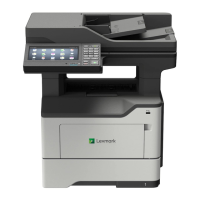VORSICHT – QUETSCHGEFAHR: Um das Risiko einer Quetschung zu vermeiden, gehen Sie in
Bereichen, die mit diesem Etikett gekennzeichnet sind, mit Vorsicht vor. Quetschungen können im
Bereich von beweglichen Komponenten auftreten, wie z. B. Zahnrädern, Klappen, Fächern und
Abdeckungen.
Troubleshooting overview
Performing the initial troubleshooting check
Before you start the troubleshooting procedures, perform the following checks:
• Use genuine Lexmark supplies and parts for the best results. Third-party supplies or parts may aect the
performance, reliability, or life of the printer and its imaging components.
• With the power cord unplugged from the electrical outlet, check that the cord is free from the breakage,
short circuits, disconnected wires, or incorrect connections.
• Make sure the printer is properly grounded. Check the power cord ground terminal.
• Make sure the power supply line voltage is within 10% of the rated line voltage.
• Make sure the machine is securely installed on a level surface in a well‑ventilated area.
• Make sure the room temperature is between 16 and 32°C (60 and 90°F) and that the relative humidity is
between 20 and 80%.
• Avoid sites generating ammonia gas, high temperature, high humidity (near water faucets, kettles,
humidifiers), cold spaces, near open flames, and dusty areas.
• Avoid sites exposed to direct sunlight.
• Make sure the paper is the recommended paper for this printer.
• Make a trial print with paper from a newly opened package, and check the result.
Power‑on Reset (POR) sequence
When you turn on the printer, it performs a POR sequence.
Check for correct POR functioning of the base printer by observing the following:
1 The control panel indicator light turns on.
2 The control panel display turns on.
3 A splash screen appears on the display.
4 The cooling fan turns on.
5 The fuser heater turns on.
Note: The fuser takes longer to warm up from a cold start than from a warm start.
6 The main drive motor turns on.
7018
Diagnostics and troubleshooting
29

